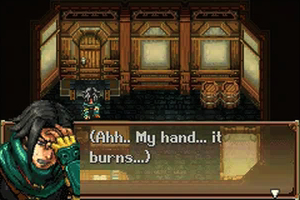
As an art student, I like to adhere by the social rules that art students are encouraged to follow as often as possible. When starting our education, we are given a guide with instructions on how to be artsy, and the good lord knows I always try to follow it to the letter.
Examples: I like to eat tofu and sushi. I don’t own nor watch television. I wear Birkenstocks. I own a Mac, and am proud of it. I pretend I understand modern art. On principle, I do not associate myself with those of the “frat” and “greek” persuasion, and I always support the little guy (except when their playing against the Red Sox).
As my interests lie within the gaming industry, it is only natural that my finely developed artistic sensibilities would have me bemoan the evil, mega-corporate game companies and support the indie game scene.
Within reason of course, I do not jump for joy every time another marble rolling game is released, but I am inspirited by the potential of the indie developer. Without the need to purge a large amount of risk, these pint sized groups allow themselves to bring to the commercial table developed concepts that challenge the fundamentals of where the industry stands today.
Our good friend Ron Gilbert seems a more dissatisfied with the indie scene than I might hope. He laments the lack of craftsmanship, saying that there is just not enough polish to in the indie scene to compete with the mega blockbusters. Ron does not fault the developers on this issue, rather states that the cost of technology is just so outrages that indie developers cannot afford the investment needed to bring their games to a level that can compete with the multi million dollar projects.
The next generation of gaming is coming, and you better have the specularity on your normal maps dialed up to a thousand and have your dynamic soft shadows softer than a kitten if you expect to achieve any sort commercial success. Right?
![]()
What indie developers need are open channels where the entrance requirements DO NOT include “hi def” graphics. These channels also must have the needed user base, one who is willing to put up with sub par technology because they know that whatever is lacking in the graphics department will be compensated for in the areas of story, gameplay, character development, art direction, concept and innovation.
These channels do exist and indie developers are finding ways to utilize them. An example is the company, Introversion Software. Pretty much the poster child of indie games, Introversion has garnered many accolades for their most recent title (March 2005), Darwinia.
While Darwinia’s graphics are not the most technically advanced, the art direction is truly something to behold. Darwinia also features great sound and of course (the reason we game in the first place) a wonderful story and amazing gameplay.
The game was developed by approximately a crew of ten, which is an amazing fact when you realize that most major titles being developed at this time feature a crew in the hundreds. Darwinia was at first only available in the UK. Nine months after Darwinia’s release, Introversion signed a deal with Valve Software to distribute the game over Steam, their own digital distribution service. This introducing the game to whole new “hard core” audience that generally would over look titles of this nature. Sales for the game automatically soared, selling more copies in the first three weeks than it had in the past nine months.
Another example comes from a fledgling company called Archcraft. While their concept is not the most original, their game Project Exile is refreshing in that it strives to improve upon the gameplay mechanics of the old 16 bit era, RPGs. In an art form similar to Chrono Trigger*, Project Exile is a very attractive game and also holds great potential in story and character development. The game is being developed by 8 people and will be released early next year for the Nintendo DS.
What makes this release interesting is that Project Exile is a modern game, developed by an indie company, in the tradition of a genre that saw its peak around a decade ago. The DS itself is a system that de-emphasizes its graphical capabilities for its potential for innovative gameplay, thus development costs for DS games is dramatically lower. The potential market is also enormous as the sales of the Nintendo DS have gone far beyond any of its competitors.
Buyers of the DS system know that they are not getting the most advanced pixel for their dollar and they are more open to games do not rely on eye candy to be appealing.
Interestingly, this ideology also applies to Nintendo’s upcoming flagship system, the Wii. While Microsoft and Sony have a pissing match in high definition, Nintendo is off by themselves, playing their own games and basically creating their own market. The Wii is not nearly as powerful as the other two, but its unique controller and low development costs state plainly that its not here for the technology arms race.
The Wii’s development kit is sated to cost less than a Sony PSP development kit. The hardware is also stated to be close in relation so the system’s predecessor, the Game Cube, therefor a wealth of knowledge is already available to those who wish to develop for the Wii. Indie developers should feel much more at home.
In contrast to what Ron Gilbert might think, indie games have a bright future, and we don’t have to wait a decade for the technology to plateau before anything interesting happens with it.
As games develop, they leave in their wake the technology of the past generations. These channels are still available! With the recent surge in retro gaming, I believe many would be open to the idea of new games coming out for old consoles. We might again see the day when excellent games are developed by a garage full of sweaty, college drop outs!
Indie developers cannot compete directly against developers with big budgets, especially in the area of technology. The key to success will be to take the steam out of the companies that use technology as their driving force.
We gamers tend to get older. Our tastes tend to mature. We no longer really care that about glitz and glam and would glady sacrafice the shiny surfaces for an experience that went deaper than just the icing, and our numbers our growing.
-roos

3 Comments so far
Leave a comment
We need to make the general community more aware of the indi-gaming movement. Can you imagine a house show much like a album release party but a game release party? Or rather a folk gaming artist selling CD’s at the next ann arbor artisan market or the craft fair? Little alternative art fairs like the are catering to the younger more progressive craft lovers. Many of which who are probably more open to neat games that their fellow folk have created.
Comment by bluelotusfeet July 10, 2006 @ 11:06 pmI like sushi and anime girls
Comment by Atredie July 12, 2006 @ 3:27 amKool Site – Can’t wait to see how it develops . . .
Comment by Walt July 12, 2006 @ 8:17 amWait – Thanks! Things should start to get interesting as the site begins to fall into strite.
Atredie *coughpeter* – your such a dork haha. I doubt you even read the article.
Comment by rooster July 12, 2006 @ 10:23 am